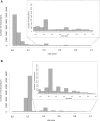MINT, the molecular interaction database: 2012 update
- PMID: 22096227
- PMCID: PMC3244991
- DOI: 10.1093/nar/gkr930
MINT, the molecular interaction database: 2012 update
Abstract
The Molecular INTeraction Database (MINT, http://mint.bio.uniroma2.it/mint/) is a public repository for protein-protein interactions (PPI) reported in peer-reviewed journals. The database grows steadily over the years and at September 2011 contains approximately 235,000 binary interactions captured from over 4750 publications. The web interface allows the users to search, visualize and download interactions data. MINT is one of the members of the International Molecular Exchange consortium (IMEx) and adopts the Molecular Interaction Ontology of the Proteomics Standard Initiative (PSI-MI) standards for curation and data exchange. MINT data are freely accessible and downloadable at http://mint.bio.uniroma2.it/mint/download.do. We report here the growth of the database, the major changes in curation policy and a new algorithm to assign a confidence to each interaction.
Figures



References
-
- Orchard S, Kerrien S, Jones P, Ceol A, Chatr-Aryamontri A, Salwinski L, Nerothin J, Hermjakob H. Submit your interaction data the IMEx way: a step by step guide to trouble-free deposition. Proteomics. 2007;7(Suppl 1):28–34. - PubMed
Publication types
MeSH terms
Substances
Grants and funding
LinkOut - more resources
Full Text Sources
Molecular Biology Databases

